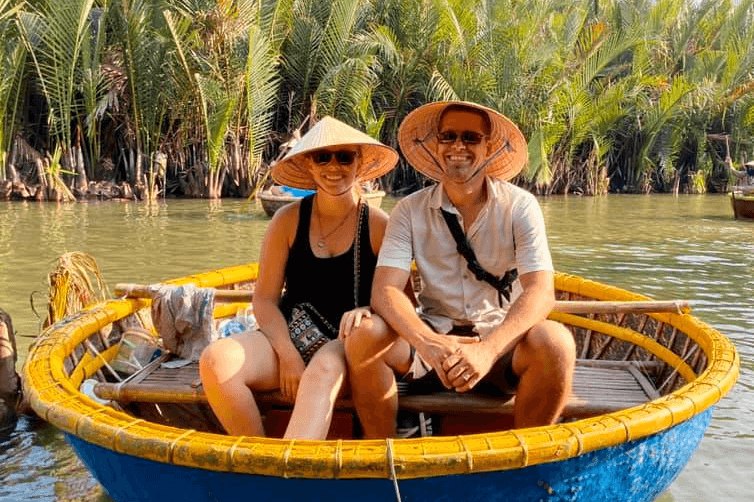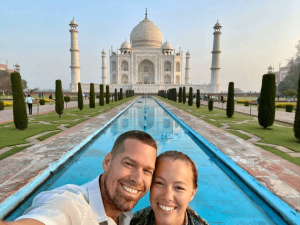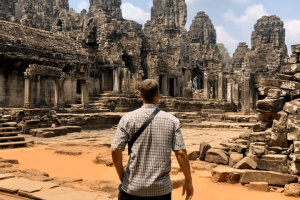Gooooood MORNING VIETNAM! It’s a fascinating country packed with proud and resilient people bearing the scars and triumphs of history and war. Neighbors to the west are Cambodia and Laos, to the north China, to the east The South China Sea and to the south-southwest is the Sea of Thailand. With 97 million people, it is the 15th most populous country in the world, but occupies a land mass smaller than California.
When we first arrived, we weren’t convinced we’d be genuinely welcomed carrying American Passports, considering the controversial role we played in their civil war. Fortunate for us, it appears the people focus less on holding a grudge and more on evolving and moving forward.
The government is communist, one could argue police-state socialist, but at heart, we’ve found the people are neither. They’re hard working opportunists and entrepreneurs wishing to be free from government tyranny. We discovered early the Vietnamese distrust of the one-party system they live under. Immediately upon arriving, while being taxied from the airport, I asked our drivers thoughts on his government. Keshia jabbed me in the ribs signaling the inappropriateness of my question. But he obliged, “Government, police… No good. No trust.” Short, simple, that’s all folks. The following day, I asked a similar question of our tour guide. There was an immediate stabbing elbow thrust into my kidneys. OUCH! I could sense Keshia’s disapproval in my peripheral vision. I ignored it — just look anywhere but her direction, I said in self-preservation. Our guide bailed me out. Turns out he liked the stage I set for him. But before he took it, he instructed us: “Never ask questions like that outside of the vehicle. Can’t trust anyone. Ten percent of the population support the government.” He then continued in a venomous rant, “We have one of the fastest growing economies in Asia, no thanks to our government…. They tax us 85 percent, but unlike other communist countries, we don’t have free education or health care…. Corruption is rampant….” on and on he went. My intent from the onset was to understand how the Vietnamese people felt about their history, current affairs and their government. I’m always curious about such things. But after that, I decided to tone down my approach and curb my impulsiveness. I don’t want anyone, included us, to get in any trouble. And I like my kidneys unbruised and fully functional.
Even if most people don’t stand with their government, they still live under its yoke. “History is written by the victors,” Winston Churchill once wrote. Visiting the War Remnants Museum in Saigon was evidence of that. Displayed within are the heroic stories and accomplishments of the Viet Cong, told with communist bravado. Above all, this museum reinforced the importance of obtaining objective data. To obtain truth, you need to independently verify facts and completely ignore pre-existing opinion. It’s good to be reminded of this from time to time, and sometimes hard in a media driven world. For the record, the museum was largely fair addressing the history of the Vietnam’s civil war. And well worth the price of admission. It was just in a foreign bias we were unfamiliar with.
Saigon was renamed Ho Chi Minh City after Vietnam’s reunification. But the people, perhaps in a silent protest, continue to call it Saigon. Regardless of what you call it, it’s a massive city, similar in size to New York. But completely unlike New York are the 9.5 million scooters swarming the roads. Driving laws are merely suggestions. Watching the flow of traffic at times made me think of a school of fish, vehicles harmoniously adjusting to merging traffic, as if connected by hive mind. At other times, it was nothing like an organized school of fish, rather resembling a battle of will and a display of chaos. At one point, while watching traffic navigate a roundabout over coffee, I thought it similar to watching an MMA fight. Like witnessing an entity on wobbled legs, with blurred vision, awaiting that inevitable devastating blow and resulting knockout. But no knockout came. Somehow the vehicles just continued wobbling and swerving forward, defying logic.
And to cross those streets…. Yeah…. Back to school we go! Timing and eye contact are important should you wish to survive. At first, we were patient; we’d make eye contact but show reluctance to step into oncoming traffic. Drivers recognized our weakness and would plow forward taking victory in the no-contest game of chicken. Eventually, in violation of all we learned growing up, we taught ourselves to leap first and think second, trying to own the role of predator feeding upon the school of fish. We’re still rookies, but we now can cross the road. As a graduation gift, Keshia purchased a shirt picturing a traffic light, with the title:
“Vietnam’s Traffic Laws.”
Written beside the green light: “You Can Go.”
Written beside the yellow light: “You Can Go.”
Written beside the red light: “You Can Still go.”
Yup. Truth there!
One day we took an unexpectedly insightful tour to ancient Hindu temples dating back to the 4th century, called My Son (beautiful mountain in Vietnamese). In addition to visiting these spectacular ruins, the drive though the countryside and narrative from our guide introduced us to the diversity of Vietnamese tribes and cultures scattered around the country. They all have their own traditional dress, dialects and customs; practicing different religions such as Buddhism, Hinduism, Taoism, Christianity, etc. On our way back to Hoi An, we glanced farmers from the vehicle window wearing traditional Vietnamese hats while plowing their rice terraces with water buffalo. In moments like this we’d long for a proper camera and zoom lens to preserve the memory in artistic form. At one such point, our guide pointed to a passing gate along the roadside, “That’s my village. Looks peaceful, right?” Pausing for dramatic effect, he eventually broke the silent agreement with, “But it’s not…,” raising his eyebrows, he concluded, “…Karaoke.” That day showcased culture, history, religion and diversity; it showcased Vietnam. Loud and proud, it also demonstrated just how much they love their damn karaoke, a fact we became abundantly aware of; painfully aware at times.
One evening we treated ourselves to a bamboo show called AO. It was a dramatic and esthetically captivating show highlighting the transition from farm to city life in acrobatics and dance. The show is a reinforcement of Vietnam’s resolve to evolve and move forward. It spoke to a people who have fought for their freedom; to a people who have adapted to rapid growth and expansion; to a people’s resolve to overcome odds and find a way to flourish and prosper. In many ways it mirrored the lessons we learned and experiences we had in this remarkable country.
Keshia and I had an interesting conversation with a well-educated Vietnamese man over coffee one morning. Long story short, he believed western governments enslave their populations by creating an addictive consumer society; that westerners are being controlled by things. It was the first time I’d heard this perspective and admittedly, he made a compelling argument. What was the most significant thing we took away from that conversation? The value of travel. We travel to learn new perspectives and viewpoints; or to borrow from Douglas Adams, to better understand “the meaning life, the universe and everything.” Like the Vietnamese, we too are moving forward and evolving; and travel facilitates and accelerates that process, making our anticipation for the next chapter that much more intense. Thank you Vietnam, you’ve been insightful and beautiful.
Up next: Episode 5, Cambodia.







